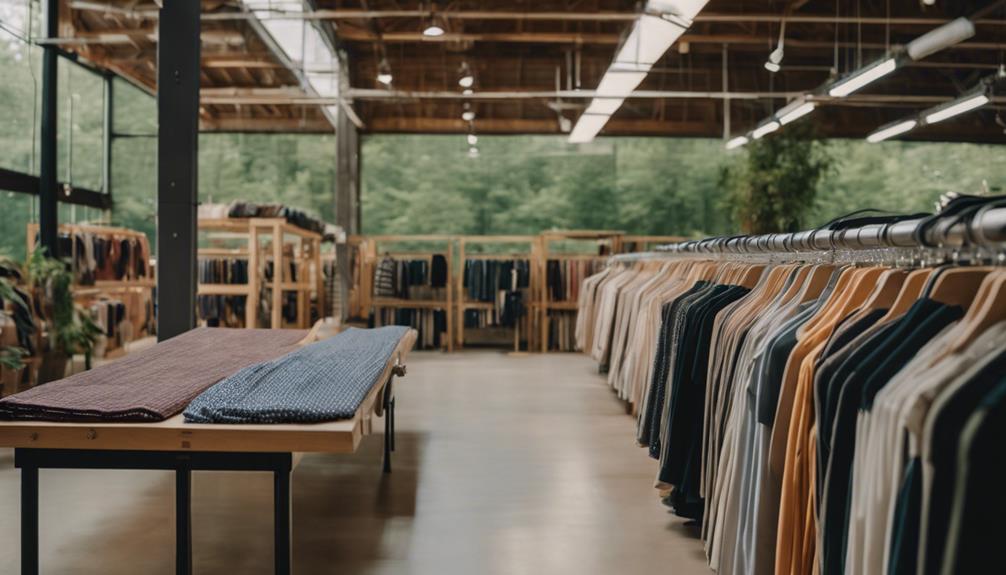The concept of sustainable fashion may sound appealing, but the reality is quite different. Despite being touted as a solution, less than 1% of clothing materials actually get recycled, and many so-called innovations fail to make a significant impact. Fast fashion continues to contribute to extensive waste, with 60% of clothing getting dumped in landfills within a year. The industry struggles with accountability and often prioritizes profits over genuine sustainability. Consumers often face limited and expensive sustainable options. By understanding the truth behind these claims, you can make more educated choices. There is still much to learn about the effectiveness of sustainable fashion initiatives.
Key Takeaways
- Sustainable fashion claims show minimal progress, with most products still made from non-biodegradable materials despite high-profile innovations.
- Less than 1% of clothing materials are recycled, leading to significant waste and economic losses, costing $100 billion annually.
- Many sustainable business models only address symptoms of the problem rather than root causes, resulting in limited effectiveness.
- Consumer education is crucial, as informed choices can significantly impact sustainability efforts and reduce fashion waste.
Industry Claims Vs. Reality
While the fashion industry touts its commitment to sustainability, the reality is that its environmental impact has barely shifted in the last quarter-century. You might think that with all the buzz around sustainable practices, things would be improving, but that's not the case. Most products are still crafted from non-biodegradable, petroleum-based materials, which contribute considerably to pollution and waste.
High-profile innovations and ESG strategies, like the use of bio-based materials, sound promising but have failed to make a real difference. You may see items marketed as carbon positive or organic, yet many of these labels don't truly address the core issues of waste and environmental degradation. The misconception that sustainability exists on a spectrum leads to the belief that 'less unsustainable' options are sufficient, but that's a dangerous oversimplification.
As more consumers become aware of these discrepancies, regulatory intervention seems increasingly necessary. Market-based solutions haven't tackled these sustainability challenges effectively, leaving you to wonder how genuine the industry's claims really are. The gap between marketing and reality is wider than you might think, and it's vital to demand more accountability from fashion brands.
Failed Innovations and Strategies
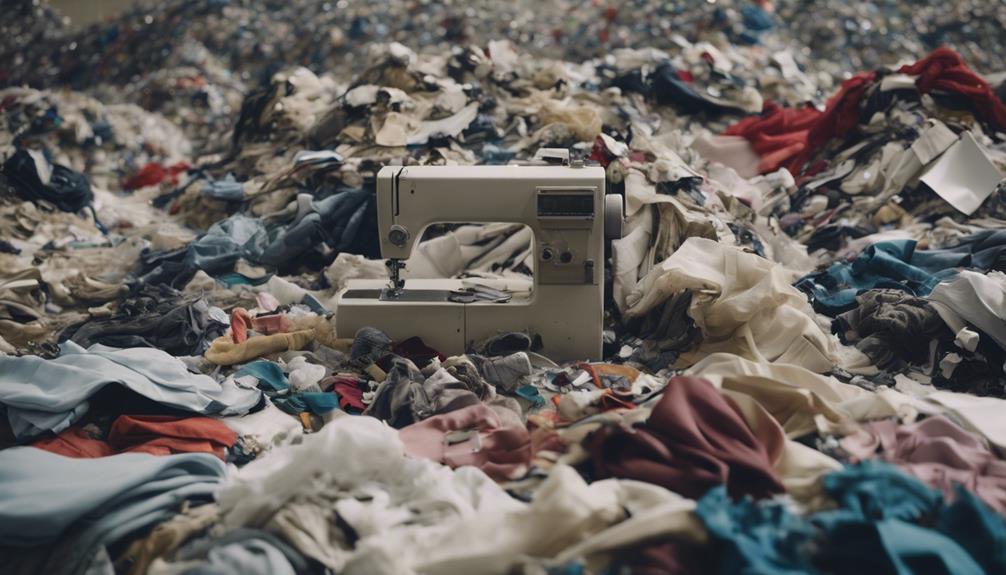
You might think that innovations like bio-based materials and recycling programs would make a real impact, but the truth is, they haven't changed the environmental toll of fashion much at all.
Many brands tout misleading sustainability claims, leading you to believe that 'less unsustainable' practices are enough, when they're not.
It's clear that the industry's current strategies are incomplete and need a serious overhaul to truly address environmental issues.
Incomplete Environmental Solutions
The fashion industry's attempts at sustainability often fall short, as many innovations and strategies fail to create meaningful environmental change. Despite high-profile advancements in sustainable fashion, the industry's overall impact remains largely unchanged over the past 25 years. Most products are still crafted from non-biodegradable, petroleum-based materials, undermining the very essence of sustainability.
You might think recycling, rental, and resale options could help, but less than 1% of clothing materials are currently recycled. This highlights the ineffectiveness of these strategies in reducing the industry's environmental footprint. In addition, the idea that sustainability exists on a spectrum can mislead consumers into believing that 'less unsustainable' practices equate to true sustainability.
Market-based solutions have also proven inadequate. Without regulatory intervention, companies often escape accountability for their environmental impacts. While the fashion industry promotes a progressive image, many claims of sustainability don't translate into genuine change in production practices.
It's vital to recognize that without significant, systemic changes, sustainable fashion remains an incomplete solution to the industry's environmental issues.
Misleading Sustainability Claims
Relying on misleading sustainability claims, many fashion brands promote innovations that fail to deliver real environmental benefits. You might think that new materials and recycling initiatives are effective, but the harsh reality is that most of these efforts don't greatly reduce the environmental impact of fashion.
Here are four key points to evaluate:
- Bio-based Materials: Despite their promotion, these materials often still rely on non-biodegradable components.
- Spectrum Misconception: The belief that sustainability exists on a gradient allows brands to present 'less unsustainable' practices as acceptable solutions, which doesn't tackle the root causes of environmental degradation.
- Market Solutions: Initiatives like Rent-the-Runway haven't greatly reduced fashion waste or encouraged sustainable practices.
- Recycling Inefficiency: Currently, less than 1% of clothing materials are recycled, resulting in an astonishing $100 billion wasted annually.
The fashion industry's reliance on these misleading sustainability claims not only obscures the truth but also hinders genuine progress.
To hold companies accountable for their negative environmental impact, regulatory intervention is essential, as voluntary commitments have proven insufficient.
Need for Regulatory Intervention

Amidst the fashion industry's claims of sustainability, urgent regulatory intervention is essential to hold companies accountable for their environmental impact.
Despite repeated promises to be more eco-friendly, the industry's environmental footprint remains largely unchanged over the past 25 years. Most companies don't adequately bear the costs of their negative impacts, making it clear that government action is necessary.
Market-based solutions have fallen short in addressing sustainability issues, highlighting the need for robust regulatory frameworks that enforce responsible practices.
Currently, a significant portion of fashion products is made from non-biodegradable materials. Without regulations promoting the use of sustainable resources, the industry continues to prioritize profit over planet.
New Business Models Limitations
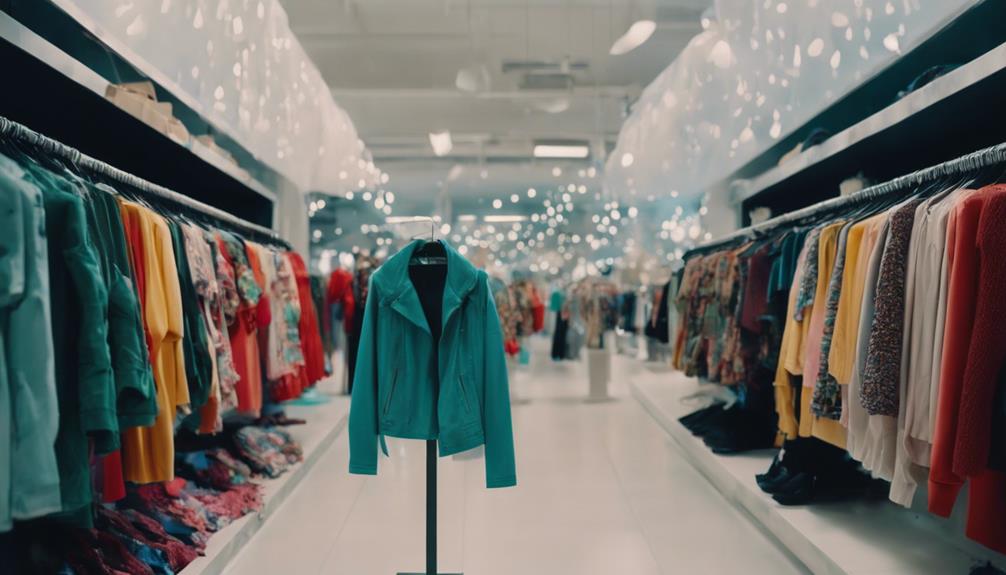
New business models in sustainable fashion often promise environmental benefits, but their true impact on the industry's overall sustainability remains uncertain. While models like recycling, resale, rental, reuse, and repair are trendy, they come with considerable limitations that you should consider:
- Surface Solutions: Many of these models focus on symptoms rather than addressing the root causes of environmental degradation in fashion.
- Consumer Behavior: Success hinges on consumer participation, which hasn't fully materialized yet; many shoppers still prioritize fast fashion over sustainability.
- Ineffective Innovations: High-profile initiatives, like Rent-the-Runway, have failed to considerably lessen the industry's environmental footprint over the years.
- Just 'Less Unsustainable': Being 'less unsustainable' doesn't mean achieving true sustainability, emphasizing the limitations of these new business models in driving meaningful change.
Ultimately, while these models offer a fresh perspective on how to engage with fashion, they often fall short of delivering genuine, long-lasting solutions. As you explore sustainable options, it's essential to remain aware of these shortcomings and push for deeper, systemic changes within the industry.
The Future of Sustainable Fashion

The future of sustainable fashion hinges on innovative practices that prioritize eco-friendliness and transparency, reshaping industry standards for a more responsible approach.
As a consumer, you'll notice that sustainable brands are increasingly adopting circular economy principles, focusing on reducing waste and utilizing eco-friendly materials. With fashion waste projected to soar to 148 million tons by 2030, it's clear that significant changes are necessary.
You'll also see a shift in consumer behavior, as 71% of millennials now prioritize sustainability in their shopping decisions. This growing awareness prompts brands to embrace eco-friendly practices, making sustainability a competitive advantage in the market.
Collaborative efforts among sustainable brands and various stakeholders are expected to drive these innovations, creating a more transparent supply chain.
Importance of Sustainable Fashion

Sustainable fashion matters because it directly addresses the harmful consequences of fast fashion, which contributes considerably to waste and pollution.
By choosing quality over quantity, you can help extend the life of your clothes and reduce environmental impact.
Embracing responsible consumer behavior not only benefits the planet but also supports fair practices in the fashion industry.
Fast Fashion Consequences
Fast fashion's rapid production cycle not only harms the environment but also jeopardizes the health of workers and future generations. The consequences are severe and multifaceted, impacting both our planet and the people who inhabit it. Here's how:
- Greenhouse Gas Emissions: The apparel and footwear industries account for 8% of global greenhouse gas emissions, contributing greatly to climate change.
- Waste Accumulation: Around 60% of clothing items end up in landfills or incinerators within a year, intensifying the fashion waste crisis.
- Water Pollution: The fashion industry is responsible for 20% of global industrial water pollution, highlighting the urgent need for sustainable practices.
- Health Risks: Fast fashion production often involves harmful chemicals and pesticides that not only damage ecosystems but also pose serious health risks to garment workers.
These factors underscore the critical importance of sustainable fashion. If you care about the environment and the welfare of workers, it's crucial to reconsider your shopping habits and choose brands that prioritize ethical practices.
Your choices can contribute to a healthier planet and a more equitable future.
Quality Over Quantity
Prioritizing quality over quantity in your wardrobe can greatly reduce waste and promote a healthier planet. When you invest in high-quality clothing, you're not just purchasing a piece; you're choosing durability that extends the lifespan of your garments. This simple shift can lower the environmental impact by up to 30% if you keep items for just nine additional months.
In contrast, fast fashion emphasizes quantity over quality, leading to a staggering 60% of clothing being discarded within a year. This contributes considerably to overflowing landfills and environmental degradation. By choosing brands that focus on quality, you support sustainable practices that often include biodegradable materials and eco-friendly production methods, minimizing harmful effects on the planet.
Embracing quality over quantity isn't just a personal choice; it's a movement toward sustainability. Each durable piece you buy adds to a more responsible fashion industry, which aims to cut down on emissions and waste.
Responsible Consumer Behavior
Understanding your role as a consumer is essential in shaping a more sustainable fashion industry and reducing its environmental impact. By practicing responsible consumer behavior, you can considerably contribute to a healthier planet.
Here are some ways you can make a difference:
- Prioritize Quality: Choose higher quality items that last longer, reducing the need for frequent replacements and minimizing waste.
- Educate Yourself: Understand the lifecycle of clothing and research brands to support those that practice ethical manufacturing.
- Donate and Repair: Instead of discarding, donate unused clothing or repair items to extend their life and reduce landfill contributions.
- Shop Secondhand: Opt for thrift or consignment stores, which can help you find unique pieces while supporting a circular economy.
Effects of Fashion Waste

Fashion waste has a staggering impact on our planet, with around 60% of clothing items ending up in landfills or incinerators within just a year of purchase. This waste not only contributes to overflowing landfills but also exacerbates greenhouse gas emissions, as the apparel and footwear industries account for about 8% of global emissions.
It's alarming to think that by 2030, the fashion industry is projected to produce 148 million tons of waste, signaling an urgent need for change. Currently, less than 1% of clothing materials are recycled, leading to an annual loss of $100 billion in potentially reusable resources.
When you consider the environmental consequences, it's critical to recognize the role of microfibers from synthetic fabrics. A single load of laundry can release over 700,000 microfibers into waterways, posing severe threats to marine life and ecosystems.
As you reflect on your fashion choices, remember that every decision contributes to the larger issue of fashion waste. By opting for sustainable brands and practices, you're not just making a purchase—you're helping combat the negative effects of fashion waste on our planet.
Fashion Waste Statistics
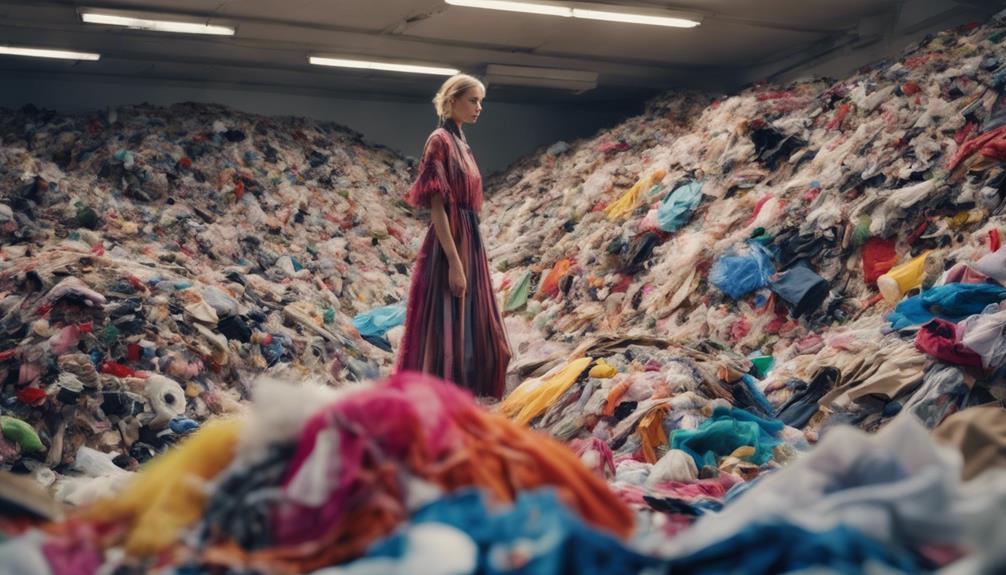
The staggering statistics surrounding fashion waste reveal the urgent need for a shift in how we consume clothing.
You might be shocked to learn that the fashion industry is responsible for about 8% of global greenhouse gas emissions. Fast fashion exacerbates this issue, with around 60% of clothing items discarded within just a year. If we don't change our habits, forecasts suggest that by 2050, fashion could consume 26% of the global carbon budget.
Here are some eye-opening fashion waste statistics to reflect on:
- Clothing utilization has plummeted by 36% over the past 15 years, reflecting a growing disposability mentality.
- Less than 1% of clothing materials are recycled, resulting in a staggering annual waste cost of nearly $100 billion.
- Fast fashion contributes considerably to landfill waste, with many items ending up in incinerators.
- The average consumer now buys 60% more clothing than in 2000, leading to increased waste.
These figures highlight the critical importance of adopting sustainable fashion practices.
It's time to rethink our consumption habits for a healthier planet.
Consumer Education and Awareness
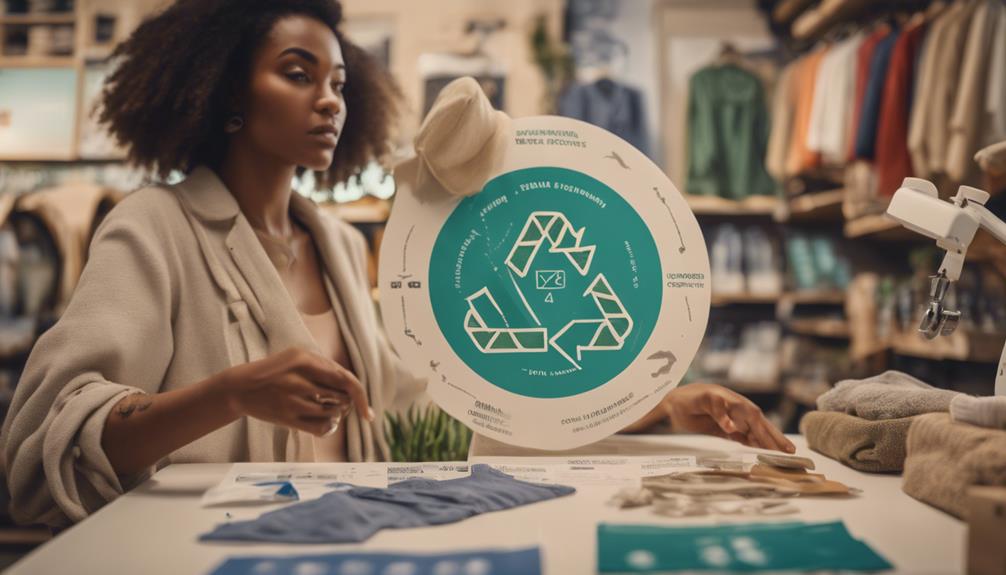
Understanding the importance of consumer education can transform your shopping habits and promote sustainability.
With resources like the Good On You app, you can easily identify brands that align with eco-friendly practices.
Importance of Awareness
Consumer education and awareness are essential because they empower you to make informed choices that prioritize sustainability in your shopping habits.
By understanding the impact of your decisions, you can contribute to a more sustainable fashion industry. Here are four key reasons why awareness matters:
- Consumer Demand: Research shows that 71% of millennials prioritize sustainability, meaning your choices can drive brands to adopt more responsible practices.
- Understanding Impact: Knowing that less than 1% of clothing materials get recycled highlights the importance of choosing brands that prioritize circularity.
- Avoiding Greenwashing: Tools like the Good On You app help you identify truly sustainable brands, ensuring your purchases reflect your values without falling for misleading marketing.
- Community Engagement: Participating in initiatives like clothing swaps raises awareness about fashion waste, fostering a culture of sustainability through social connections.
When you become more aware, you not only enhance your own shopping experience, but you also encourage brands to adopt ethical practices.
Your informed choices can spark a ripple effect, inspiring others to think critically about their fashion consumption.
Resources for Education
Frequently exploring resources for education on sustainable fashion can greatly enhance your ability to make informed and responsible purchasing decisions. Tools like the 'Good On You' app help you identify sustainable brands and steer clear of greenwashing. You'll find podcasts and guides that investigate the environmental impacts of the fashion industry, making you more aware of ethical considerations.
Here's a quick look at some essential resources:
| Resource Type | Purpose |
|---|---|
| Apps | Identify sustainable brands and avoid greenwashing |
| Podcasts | Educate on sustainable practices in fashion |
| Workshops/Events | Share knowledge and empower community involvement |
Challenges to Sustainable Fashion
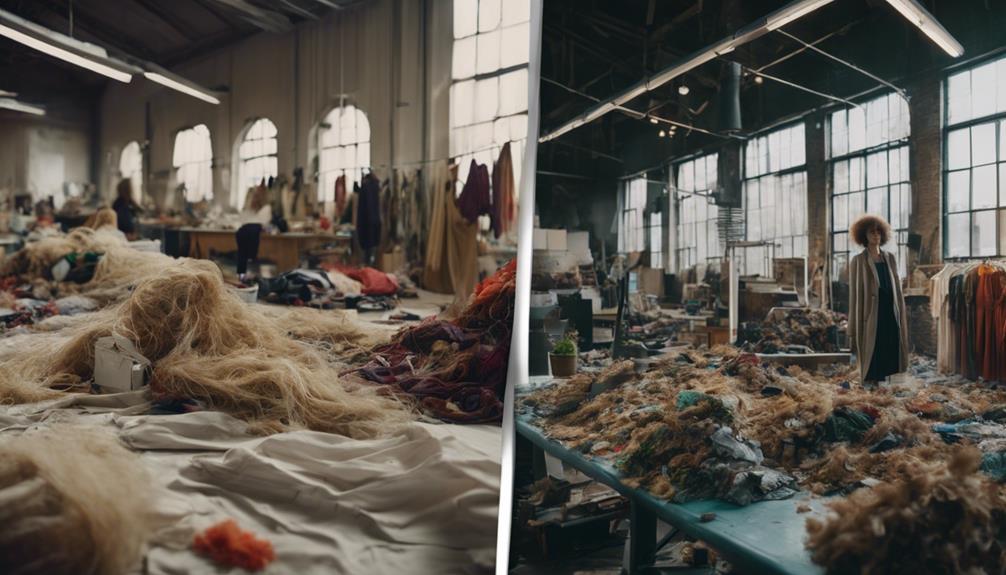
One major hurdle for sustainable fashion is the widespread misconception that eco-friendly products always come with a hefty price tag. This belief can deter many consumers from exploring sustainable options, creating significant challenges for the industry.
Here are some key issues you should be aware of:
- Consumer Reluctance: About 26% of business owners report low consumer willingness to pay more for sustainable products as a major obstacle.
- Limited Availability: Sustainable choices are often hard to find in mainstream retail, as fast fashion dominates the market.
- Fast Fashion Pressure: The trend-focused demand pushes brands to prioritize speed and volume, neglecting sustainability.
- Industry Commitment: There's a pressing need for greater industry-wide dedication to sustainability, as current efforts often miss the root causes of environmental degradation.
These challenges not only affect consumer choices but also hinder the broader acceptance of sustainable fashion.
If you want to contribute to a more sustainable future, recognizing and overcoming these hurdles is essential. By making informed choices, you can help shift the industry toward better practices.
Frequently Asked Questions
How Sustainable Is Sustainable Fashion?
You might think sustainable fashion is effective, but it's often not. With less than 1% of materials recycled and significant waste generated, true sustainability requires deeper systemic changes rather than just trendy innovations.
Why Is Sustainable Fashion so Important?
Picture a overflowing landfill, clothes choking the earth. Sustainable fashion's importance lies in reducing this waste, promoting ethical practices, and supporting lasting quality. You can make a difference by choosing brands that prioritize our planet.
What Does Sustainability Mean to You in Fashion?
Sustainability in fashion means you prioritize eco-friendly materials and ethical production. It's about choosing quality over quantity, supporting brands that respect the planet, and embracing practices that reduce waste and promote circularity in your wardrobe.
Do People Really Care About Sustainable Fashion?
Yes, people really care about sustainable fashion. You're part of a growing movement prioritizing eco-friendly choices, pushing brands to innovate. As awareness increases, consumers like you demand stylish, responsible options that reflect your values.
What Are the Surprising Ways in Which Sustainable Fashion Is Achievable?
There are various ways to achieve sustainable fashion strategies that can surprise you. Embracing circular fashion, upcycling and recycling clothing, and opting for organic and sustainable materials are some effective ways. Collaborating with ethical and eco-friendly fashion brands and swapping or renting clothes also contribute to achieving sustainable fashion strategies.
How Can Sustainable Fashion Impact Aesthetic Choices?
Sustainable fashion has the power to influence aesthetic choices. Designers who embrace eco-friendly materials and ethical production methods can create outofthisworld aesthetic amazes everyone. This shift towards responsible fashion can inspire consumers to prioritize timeless, quality pieces over fast fashion trends, ultimately shaping our collective aesthetic preferences.
Conclusion
In the quest for sustainable fashion, it's easy to get lost in the buzzwords and flashy marketing.
Sure, brands may claim they're eco-friendly, but the reality often falls short.
You've got to stay savvy—think critically about what you buy.
The future of fashion depends on your choices.
So, don your thinking cap and embrace a wardrobe that truly reflects your values.
Remember, when it comes to sustainability, the proof's in the pudding!

